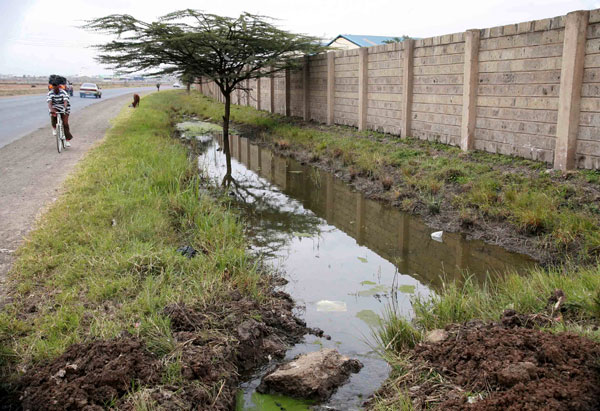By Joyce Chimbi
Housing Expansion Strains Water Supply, Provokes Flooding
NAIROBI – High rise apartments have sprung up and the area is desperately crowded. It has serious water and sewage problems. Open sewers flows freely. When it rains, the area is impassable. There are no clear roads.
Muddy water, sewage and garbage form a cocktail in the Embakasi area around Jomo Kenyatta International Airport bespeaking an epidemic waiting to happen. A powerful stench pervades the air. Construction of apartment buildings, roads and sidewalks has left little soil to absorb heavy rain. The result is periodic flooding. An increase in new apartment dwellers has led to a shortage of drinking water.
Jackie Kagwe, who lives in Embakasi, said there have been times when she has not had running water for a month. “ I have resorted to buying water at very exorbitant prices,” she said. “water that at times has a foul smell and is foamy.”
“This has made me desperate to move to another house,” she said. “But moving is expensive. I am barely managing to pay my rent of about $50 a month.”
Thousands of people in Kenya and millions of people around the world are facing similar experiences as populations continue to shift from the countryside to cities. By 2008, for the first time, more than half the world’s population was concentrated in cities around the world. Demand for water in many cities is rising sharply and governments are often unable to cope. Millions in the countryside also are dangerously short on water. According to international health agencies, about 1 billion people in cities and in rural areas do not have regular access to clean water.
The troubled neighborhood of Embakasi is a constituency or district in Nairobi, about four miles east of downtown. It is home to an estimated 250,000 people, more than three times the population of an average constituency.
The people of Embakasi are mostly low and middle-income workers from the countryside. The land is reasonably affordable; it is usually a dry place. But when it rains, there is no place for the water to go. The water simply rushes off the new sidewalks and roads. Drainage ditches ease the flooding, but often overflow.
But the demand for housing has led to the building of as many rental units as a small piece of land can accommodate. The units are being built by young investors in their 40’s, mostly people who have been able to take advantage of friendly bank loans.
“The water pipes were not meant to cater for such a high population,” said Donnga Mwathi, a City Council employee. “The capacity of the pipes is limited.”
The Embakasi scenario is been replicated in other parts of Nairobi. And people in those places are also struggling with water shortages.
Kenya has reorganized its Ministry of Water and Irrigation. It says it is planning to repair the Sasuma Dam, a reservoir with the capacity to greatly alleviate the water crisis in Nairobi.
In Embakasi, Mr. Mwathi, the City Council employee, said there have been no clear demarcations of where water lines are placed. “And with buildings coming up on any available space,” he said, “attending to the water pipes has become impossible.” #

